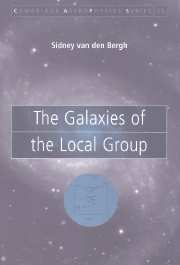Book contents
- Frontmatter
- Contents
- Preface
- 1 Introduction
- 2 Local Group membership
- 3 The Andromeda galaxy (M31)
- 4 The Milky Way system
- 5 The Triangulum galaxy (M33)
- 6 The Large Magellanic Cloud
- 7 The Small Magellanic Cloud
- 8 The elliptical galaxy M32 (= NGC 221)
- 9 The irregular dwarf galaxy NGC 6822
- 10 The starburst galaxy IC 10
- 11 Faint dwarf irregular galaxies
- 12 Spheroidal galaxies
- 13 The most luminous dwarf spheroidal galaxies
- 14 Dwarf spheroidals in the Andromeda subgroup
- 15 Faint dwarf spheroidals
- 16 The outer fringes of the Local Group
- 17 Intergalactic matter in the Local Group
- 18 Dynamical and physical evolution
- 19 Properties of the Local Group
- 20 Conclusions
- Glossary
- Bibliography
- Object Index
9 - The irregular dwarf galaxy NGC 6822
Published online by Cambridge University Press: 22 August 2009
- Frontmatter
- Contents
- Preface
- 1 Introduction
- 2 Local Group membership
- 3 The Andromeda galaxy (M31)
- 4 The Milky Way system
- 5 The Triangulum galaxy (M33)
- 6 The Large Magellanic Cloud
- 7 The Small Magellanic Cloud
- 8 The elliptical galaxy M32 (= NGC 221)
- 9 The irregular dwarf galaxy NGC 6822
- 10 The starburst galaxy IC 10
- 11 Faint dwarf irregular galaxies
- 12 Spheroidal galaxies
- 13 The most luminous dwarf spheroidal galaxies
- 14 Dwarf spheroidals in the Andromeda subgroup
- 15 Faint dwarf spheroidals
- 16 The outer fringes of the Local Group
- 17 Intergalactic matter in the Local Group
- 18 Dynamical and physical evolution
- 19 Properties of the Local Group
- 20 Conclusions
- Glossary
- Bibliography
- Object Index
Summary
Introduction
NGC 6822 is a barred dwarf galaxy of type Ir IV–V that islocated at relatively low Galactic latitude. The first detailed study of this galaxy was by Hubble (1925c) who discovered 11 Cepheid variables. Hubble wrote “Cepheid variables, diffuse nebulae, dimensions, density, and distribution of stellar luminosities agree in defining the system as a curiously faithful copy of the [C]louds, but removed to a vastly greater distance. N.G.C. 6822 lies far outside the limits of the [G]alactic system, even as outlined by the globular clusters, and hence may serve as a stepping-stone for speculation concerning the habitants of space beyond.” From these observations Hubble (1936, p. 124) was able to establish that NGC 6822 is a relatively nearby member of the Local Group. Hubble also discovered nine nonstellar objects in this galaxy. Some of these are young star clusters embedded in nebulosity, whereas others appear to be old star clusters. Hubble's cluster VII has been studied by Cohen & Blakeslee (1998), who find that it is a typical metal-poor globular cluster with a metallicity [Fe/H]=-1.95±0.15 and an age of ∼11 Gyr. It would be interesting to determine the morphology of the horizontal branch of this cluster. Hodge (1977) gives V =16.28 for the cluster Hubble VII, from which MV ≈-8.0. Cluster Hubble VI is a much younger object with an age of ∼2 Gyr and a metallicity of [Fe/H]≈-1.0, a value similar to the present abundance of the interstellar medium in this galaxy.
- Type
- Chapter
- Information
- The Galaxies of the Local Group , pp. 170 - 176Publisher: Cambridge University PressPrint publication year: 2000

